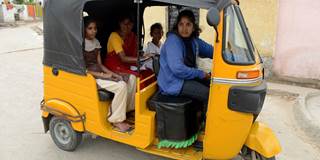Despite rising education levels, only about a quarter of Indian women work; inadequate and unsafe public transportation is a major reason. To increase female participation in the labor force, one of the most promising solutions is to upgrade an old favorite.
BENGALURU – When resources are limited, it is human capital that defines the sustainable development of a community, especially in the case of costly misallocation and underutilization, as is often the case in developing countries. Nowhere is this truer than in India, where the value of the current demographic dividend hinges on a grossly underutilized resource pool – the female workforce.
Despite rising education levels and a female literacy rate of 65%, only about a quarter of Indian women participate in the labor force. Increasing women’s workforce participation by a mere ten percentage points could add $700 billion to India’s GDP by 2025. And that requires removing one of the main obstacles to achieving this objective: broken transportation services.
Astha (name changed), a 35-year-old teacher working in the district headquarters of Jhunjhunu, in the state of Rajasthan, is one of the youngest teachers ever to be nominated for a promotion to school headmistress. But accepting the promotion meant transferring farther away from home. She took the new position, only to find the commute difficult and unsafe, as she left in the early hours of the morning, walking 1.5-2 kilometers every day. Two months into her new role, unable to depend on being escorted by family members to the bus depot daily, she gave up the job and returned to a lower position at the nearby school. Lack of reliable transportation led her to give up this opportunity.

BENGALURU – When resources are limited, it is human capital that defines the sustainable development of a community, especially in the case of costly misallocation and underutilization, as is often the case in developing countries. Nowhere is this truer than in India, where the value of the current demographic dividend hinges on a grossly underutilized resource pool – the female workforce.
Despite rising education levels and a female literacy rate of 65%, only about a quarter of Indian women participate in the labor force. Increasing women’s workforce participation by a mere ten percentage points could add $700 billion to India’s GDP by 2025. And that requires removing one of the main obstacles to achieving this objective: broken transportation services.
Astha (name changed), a 35-year-old teacher working in the district headquarters of Jhunjhunu, in the state of Rajasthan, is one of the youngest teachers ever to be nominated for a promotion to school headmistress. But accepting the promotion meant transferring farther away from home. She took the new position, only to find the commute difficult and unsafe, as she left in the early hours of the morning, walking 1.5-2 kilometers every day. Two months into her new role, unable to depend on being escorted by family members to the bus depot daily, she gave up the job and returned to a lower position at the nearby school. Lack of reliable transportation led her to give up this opportunity.